#gay gay-lussac
Text
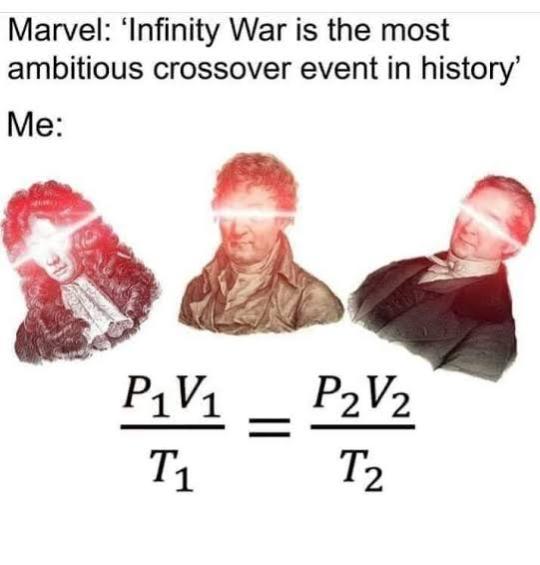
#vik's posts#charles' law#boyle's law#gay lussac's law#ideal gas law#vik's studyblr#studyblr#stem#science side of tumblr#meme
5 notes
·
View notes
Text
Ley de Boyle y Charles Gay-Lussac.
Sencillo experimento para explicar la ley de Boyle y Charles Gay-Lussac con un globo y una botella de plástico.
youtube
Ley de Boyle: A temperatura constante, la presión y el volumen son inversamente proporcionales. Al apretar la botella disminuye el volumen y aumenta la presión, lo que hace que el globo escape. Ley de Charles y Gay-Lusaac: A volumen constante, la presión y la temperatura son directamente proporcionales. Al aumentar la temperatura, aumenta el movimiento de las partículas de aire que hay en el interior, aumentando la presión y haciendo que el globo escape.
#leyes de los gases#ley de boyle#ley de gay-lussac#teoría cinética#curiosidadescientíficas#ciencia#química#física
2 notes
·
View notes
Text
ELEMENTLERİN HİKÂYESİ | BÖLÜM 18: “SPEKTRUM, IŞIK VE RENKLER III” (In, I, Cs)
İndiyum, iyot ve sezyum… Bir önceki bölümde de söylediğimiz gibi bu bölümde de isimleri spektrumlarıyla ve renkleriyle doğrudan bağlantılı olan diğer bir 3 elementi konu alıyoruz. Peki, bu bölümde ele alacağımız üç element ne zaman keşfedildi? Bu elementlerin hangi renklerle yahut spektrum analizleriyle ilişkisi vardı? Elementlerimizin keşfi sırasında ne gibi olaylar yaşandı? Elementlerin…

View On WordPress
#bernard courtois iyot#elementlerin hikayesi#ferdinand reich indiyum#gustav kirchhoff sezyum#hieronymous theodor richter indiyum#humphry davy iyot#indiyum#indiyum adı nereden geliyor#indiyum etimoloji#indiyum kaşifi#indiyum keşfi#iyot#iyot adı nereden geliyor#iyot etimoloji#iyot kaşifi#iyot keşfi#joseph louis gay-lussac iyot#robert bunsen sezyum#sezyum#sezyum adı nereden geliyor#sezyum etimoloji#sezyum kaşifi#sezyum keşfi#spektroskopi
0 notes
Text
revising chapter 4 of physics sending me into a huge spiral bc i tote forgot abt everything in that chapter FUCK
1 note
·
View note
Text
Pressure
Introduction
Pressure is a fundamental concept in physics, engineering, and various scientific disciplines. It is defined as the force applied per unit area. In a more general sense, it can also be considered as the measure of the force that a fluid exerts on its surroundings.
Basic Definition
The basic definition of pressure $P$ is given by the equation:
$P = \dfrac{F}{A}$
where $F$ is the…
View On WordPress
#Boyle&039;s Law#Charles&039; Law#First Law of Thermodynamics#Gay-Lussac&039;s Law#Ideal Gas Law#Index#Pressure#Thermodynamics
0 notes
Text
Happy Pride month to my man Lussac
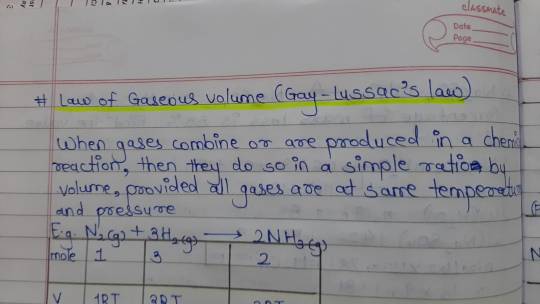
0 notes
Text

Gas Laws
A gas law is, simply put, a physical law that describes the behavior of gases. There are multiple gas laws, including the following four laws that are more well known than others:
Boyle's Law relates the pressure and volume of a gas. Published by Robert Boyle in 1662 it states that "the volume of a given mass of a gas is inversely proportional to its pressure at a constant temperature". One mathematical representation of this law is P1 x V1 = P2 x V2.
Charles' Law was published in 1787 by Jacques Charles. It relates temperature and volume and states that "volume of a given fixed mass of a dry gas is directly proportional to its absolute temperature at a constant pressure". One mathematical representation of this law is V1/T1 = V2/T2
Gay-Lussac’s Law was published by Joseph Louis Gay-Lussac in 1808 and relates pressure and temperature, stating: "The pressure exerted by a given mass and constant volume of an ideal gas on the sides of its container is directly proportional to its absolute temperature." One mathematical representation of this law is P1/T1 = P2/T2.
Finally, Avogadro's Law relates the amount and volume of a gas. It was published in 1811 by Amedeo Avogadro and states that the "volume occupied by an ideal gas at a constant temperature is directly proportional to the number of molecules of the gas present in the container." One mathematical representation of this law is V1/n1 = V2/n2.
Sources/Further reading: (Image source - LibreTexts) (NIH) (Jove) (Wikipedia)
*P - pressure; V - volume; T - temperature; n - amount of a substance
53 notes
·
View notes
Text
@andthe6 continued from wintery prompt
the creak of his floorboards for once brings him reprieve, instead of annoyance. enjolras has been savouring the artificial warmth of his apartment after a night spent at the library, and a morning in the campus’ auditorium. he half-expected company. courfeyrac is a given, on cold days like this. m. enjolras seniour foots the electricity bill, though matthieu doubts he’s aware of it, so the central heating runs, day and night. the tousled, unconscious form of grantaire on his couch gives him pause, however. as does the alarming realization that he can recognize the back of his neck, turned away as he is. he recognizes envy settling in his gut, but attributes it to being so tired himself. what he wishes for himself is sleep, not whatever activities preceded his guests’ slumber.
enjolras’ wish is granted the moment his golden head hits the pillow, rising only due to the incessant buzzing of his phone. messages announcing safety and shared locations stop him from muting it. he gazes through heavy lids out the window, the undeniable fall of snow gives context for the group chat panic of the day. most of the amis are home. marius is at chez fauchelevent, bless him. courf and ferre have found shelter at the cinema (?). one person is not accounted for – technically two considering he himself has yet to respond. enjolras’ heart rate rises as running a marathon, had grantaire ventured out in the cold? the door connecting his bedroom to the living room swings open with a violent thud. the disoriented and slightly accusatory expression of a sleepy abandoned guest pops up from behind the couch. “ oh. ” they stare, as if the other person were insane and enjolras has never felt less comfortable in his own home. “ you’re still here. ”
tequila might not actually kill you, but it might lead to some questionable decisions that makes you wish that it would. for the most part grantaire can drink exactly the amounts he needs to to get by without severe repercussions. the going to the club and licking salt, lemon and liquor off strangers’ abs is a new one and entirely owed to the ingenious of courfeyrac. dear courfeyrac, who will kiss you just to cheer you up in the spirit of friendship and courfeyrac, who happened to shower in the morning, using enjolras’ body-wash and who probably dried himself using his towels. courfeyrac who— if you squint— has a torso with the same definition and same amount of body fat. he’s a substitute, a fix, a hit, but he is never quite right. he’s always assumed that he is aware of it, too, and that he, when he initiates, feels a similar loneliness. sex is their shared solution.
grantaire, for the most part, has enough self-respect to keep clear of combeferre and enjolras’ place and besides rue gay-lussac is almost always closer (which means distance can’t be the excuse). he doesn’t remember agreeing to going to theirs, or if he had even tried to protest it. absurdly— considering the nature of his mind— he doesn’t really remember thinking much at all. he remembers being with courfeyrac in a bathroom stall one moment and on the couch the next. enjolras’ couch.
when he wakes up it is because his mouth is agonizingly dry. the absence of courfeyrac is not surprising. the boy always has some place he needs to be whereas grantaire has nothing. he prefers the days where he is unconscious for most of it and he isn’t surprised that courfeyrac knows as much. so, grantaire considers it concern rather than neglect. the only thing he is slightly bitter about is the fact that he has to get up and get himself some water and that it will inevitably delay him going back to sleep.
it would be lying saying that he is just about to leap off the sofa when he hears a door open behind him. grantaire is still very much on his back contemplating whether or not he’d die from dehydration if he just stayed still for another couple of hours. the fact that he isn’t alone startles him enough to make him sit up (he supposes he should be grateful for the push) and the fact that it is enjolras, of all people, makes his stomach churn. there’s a very real possibility that he will be sick all over their fancy furniture.
he fixates on a tiny loose string by the collar of enjolras’ t-shirt instead of his eyes. grantaire doesn’t want to see the frustration he already hears palpably in the tone of his voice. “yeah,” he replies eventually, patting himself on the chest, “still here.” he is still groggy from sleep, his voice is nearly gone and he lacks a clever thing to say. he lets out an audibly grunt when he’s about to get up and he realizes he can’t. he’s naked. sure, he’s got a blanket covering him up, but he’s definitely too naked to move. he feels heat rise in his cheeks and around his ears, he feels humiliated and ashamed.
“fuck, man, i didn’t think anybody was home except for courfeyrac. i wouldn’t have…” an awkward, fumbling pause, “i’ll have to find my clothes.. but then i’ll be out of your way, i promise. i promise.”
#andthe6#ch: bastien grantaire.#ic threads.#I HAD TO#in which r doesn't even know about the snow and is a mess
5 notes
·
View notes
Photo
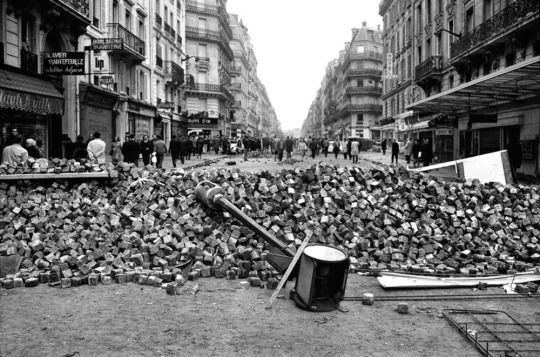
Bruno Barbey - Paris. 5e arrondissement. Quartier latin. Rue Gay Lussac. Le matin du 11 mai 1968.
29 notes
·
View notes
Text
THIS DAY IN GAY HISTORY
based on: The White Crane Institute's 'Gay Wisdom', Gay Birthdays, Gay For Today, Famous GLBT, glbt-Gay Encylopedia, Today in Gay History, Wikipedia, and more …


1660 – Cardinal Francesco Maria de' Medici, was born in Florence, the son of Grand duke Ferdinando II of Tuscany and Vittoria Della Rovere (d.1711).
In 1683 he was appointed to governor of Siena, a position he maintained until his death. He was the grand prior of the Sovereign Order of Malta in Pisa; Abbot commendatario of S. Galgano, Siena; Abbot commendatario of S. Stefano, Carrara, 1675.
According to a family tradition was promoted to the cardinalate at a young age in 1686. He remained in Florence, in his villa of Lappeggi, devoting himself to a life not really religious, made of amusements and love affairs with men.
He resigned the cardinalate on June 19, 1709 and was named prince of Siena. He then was forced to marry in 1709 Eleonore Luisa Gonzaga, duchess of Guastalla, daughter of Vincenzo Gonzaga, in an attempt to save the dynasty, but they did not have children.


1746 – Jacques Charles (d.1823) was a French mathematician and inventor, best known for his work with the hydrogen balloon.
Jacques was the only child of his parents. Jacques' education consisted of basic arithmetic , and no science at all. Other than this almost nothing is known about his earlier years.
Late in life Jacques married a creole woman, Julie Françoise Bouchaud des Hérettes, who was 37 years younger than himself. Many historians believe that his marriage was a cover up for his homosexual relationship with the poet, Alphonse de Lamartine.
In 1785 Charles became a professor at the French Académie des Sciences without having any formal science education himself.
Without Charles's contributions, the Hindenburg would not have even existed, so that accident would not have occurred, and we wouldn't have the one-way valve, or at least until someone else came up for the idea after Charles did.
Most notably Jacques Charles is known for the Hydrogen balloon which he built with the Robert Brothers. Jacques originally got the idea for using hydrogen gas as a lifting agent after intensive study of Boyle's Law. Previous to the use of hydrogen gas, hot air was used to make balloons fly.
Charles also is known for the invention of the gas valve, which he used on his hydrogen balloons, the hydrometer, and the reflection goniometer. He improved the heilostat and the arometer. Charles also confirmed Benjamin Franklin's electrical experiments. Charles is also responsible for Charles's Law, but did not publish it. It was published by Joseph Gay-Lussac in 1802, and Joseph named it in Charles's honor, crediting an unpublished work by Jacques Charles.
Jacques Charles outlived his young wife, and later died himself April 7, 1823 in Paris.


1915 – Roland Barthes (d.1980), a French semanticist, symbolist, and philosopher, like André Gide and Marcel Proust, two of his favorite writers, was somewhat of an outsider. He was Protestant. (France is predominantly Catholic.) He was left-handed. (France is, of course, predominantly right-handed.) He was déclassé. (Barthes's father, a naval officer, died in the First World War, and his mother had to work as a bookbinder.) He was consumptive. (Barthes spent several years in sanatoria.) And he was expatriate. (Barthes spent the 1950s in the Middle East and Eastern Europe, working for cultural services.) He was also, like Proust, (if not like Gide, who saw himself as a pederast), a homosexual.
Barthes's critical writings are best understood in relation to this sexual marginality. Because Barthes sees homosexuality, and for that matter any transgressive and eccentric "perversion," as unclassifiable, he rejects the classification "inversion" as inaccurate—a notion that will come as a surprise to gays and lesbians who see themselves as "inverts."
Oddly enough, Barthes does not reject every gay male stereotype. Barthes rejects sexual inversion, but embraces "tricking" and "cruising," activities that he claims represent true sexual liberation. (Not that they did so for Barthes himself; his autobiographical texts suggest he had an unhappy love life.) Cruising, he writes, is "anti-natural, anti-repetition." It may be that Barthes is simply "protecting" his sexuality here (something he feels all writers do), or at least the macho ("phallocentric") part of his sexuality because whereas sexual inversion feminizes gay men, cruising for tricks is a rather manly (and purportedly desirable) thing to do.
Barthes sees tricking and cruising as desirable in another sense as well. The trick, he writes, "is homogenous to the amorous progression; it is a virtual love, deliberately stopped short on each side, by contract." Likewise, men cruise with "the invincible idea that one will find someone with whom to be in love." Some gays (who cruise for sex, not love) will find these descriptions unrealistic. Barthes, however, feels that sentimentality, in an age such as ours in which love doesn't make too much sense, is essentially—and even nonparadoxically—insignificant.
According to Barthes, "it is Western discourse as such" —discourse that marginalizes and stereotypes gays and lesbians—" that we must now try to break apart."


1946 – James F. Amos is a retired United States Marine Corps four-star general who served as the 35th Commandant of the Marine Corps. As a Naval Aviator, Amos commanded the 3rd Marine Aircraft Wing during the Iraq War in 2003 and 2004. He served as the 31st Assistant Commandant of the Marine Corps. He is the first Marine Corps aviator to serve as commandant.
As Commandant, Amos opposed the repeal of the "don't ask, don't tell" policy regarding homosexuals openly serving in the U.S. military. After President Obama signed the legislation setting the conditions for repeal, Amos led the Department of Defense in carrying out the will of the nation's civilian leadership. In late November 2011, Amos stated that his opposition to gays openly serving in the military has proven unfounded and said that Marines have embraced the change, describing the repeal as a "non-event."
1947 – A New York appellate court overturns the sodomy conviction of a "man of education and culture" accused by a mentally retarded vagrant, thus showing class bias.


1958 – Eric Marcus, born in New York City, is an American non-fiction writer. His works are primarily of LGBT interest, including Breaking the Surface, the autobiography of gay Olympic diving champion Greg Louganis, which became a #1 New York Times Bestseller and Making History: The Struggle for Gay and Lesbian Equal Rights, 1945-1990, which won the Stonewall Book Award. Other topics he's addressed in his writing include suicide and pessimistic humor.
Marcus received his B.A. from Vassar College in 1980 where he majored in Urban Studies. He earned his Master's degree from Columbia University Graduate School of Journalism in 1984 and a Master's degree in real estate development in 2003, also from Columbia University. He was an associate producer for Good Morning America and CBS Morning News.
Eric Marcus is the American Foundation for Suicide Prevention’s Senior Director for Loss and Bereavement Programs. He wrote his best-seller Why Suicide? in order to come to terms with his own father's suicide when Eric was twelve years old.
Other popular works include What If Someone I Know Is Gay? Answers to Questions about What It Means to be Gay and Lesbian, and The Male Couple's Guide: Finding a Man, Making a Home, Building a Life.


1970 – Craig Parker, born in Suva, Fiji, is an actor from New Zealand, known for his roles as Haldir in the films The Fellowship of the Ring (2001) and The Two Towers (2002), Darken Rahl in the television series Legend of the Seeker, Stéphane Narcisse in the CW television series Reign, and Gaius Claudius Glaber in the television series Spartacus.He also serves as narrator for New Zealand documentaries. Parker starred in the TVNZ soap Shortland Street, as Guy Warner, a character that has made several return appearances, most recently involving a story where Guy ran off with his brother's wife, Toni, only to return months later as a drug addled loser who attempted to use his daughter to score drugs for him. It ultimately led to the death storyline of Toni Warner. He is the reigning champion of New Zealand's Celebrity Joker Poker.
Parker first publicly discussed being gay in an interview with New Zealand’s Sunday Herald back in 2008. Regarding his sexuality, the very private Parker told the reporter that as a gay man, he doesn’t care what people say about his sexuality and that:
It’s jut not an issue for me. I just don’t get why an actor would want to reveal their secrets, hopes and fears to a magazine or newspaper. I know what the magazine gets out of it, but not the person. If you are doing publicity to increase your self-confidence then you are really in trouble. It’s important to keep some privacy. Your friends and family are the people you reveal yourself to. They are the ones who should have real access to you.


1980 – James Ryan Clabots , best known as Jimmy Clabots, is an American physical therapist, actor, and screenwriter. In 2009 he became a male escort, and retired in 2012. Since 2014 he’s been working as a writer and physical therapist in Los Angeles.
In 2000 he became a model. In 2008 Clabots started his career as an actor in the comedy film Another Gay Sequel: Gays Gone Wild!. In 2011 he starred in Showtime's Gigolos, showing male escorts in Las Vegas, but left the show in 2012 when he retired from escorting.

Clabots is of Cuban and Spanish descent.

1964 – The first depiction of a same-sex relationship is found in an Egyptian tomb. Nyankh-khnum and Khnum-hotep are discovered buried together side by side. The wall art shows the two men kissing. They were ancient Egyptian royal servants. They shared the title of Overseer of the Manicurists in the Palace of King Nyuserre Ini, sixth pharaoh of the Fifth Dynasty, reigning during the second half of the 25th century BC. They were buried together at Saqqara and are listed as "royal confidants" in their joint tomb.

The Embrace of Niankhkhnum and Khnumhotep


7 notes
·
View notes
Text
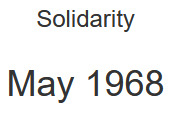
Rue Gay-Lussac
Sunday 12 May
The rue Gay-Lussac still carries the scars of the ‘night of the barricades’. Burnt out cars line the pavement, their carcasses a dirty grey under the missing paint. The cobbles, cleared from the middle of the road, lie in huge mounds on either side. A vague smell of tear gas still lingers in the air.
At the junction with the rue des Ursulines lies a building site, its wire mesh fence breached in several places. From here came material for at least a dozen barricades: planks, wheelbarrows, metal drums, steel girders, cement mixers, blocks of stone. The site also yielded a pneumatic drill. The students couldn’t use it, of course — not until a passing building worker showed them how, perhaps the first worker actively to support the student revolt. Once broken. the road surface provided cobbles, soon put to a variety of uses. All that is already history.
People are walking up and down the street, as if trying to convince themselves that it really happened. They aren’t students. The students themselves know what happened and why it happened. They aren’t local inhabitants either, The local inhabitants saw what happened, the viciousness of the CRS charges, the assaults on the wounded, the attacks on innocent bystanders, the unleashed fury of the state machine against those who had challenged it. The people in the streets are the ordinary people of Paris, people from neighbouring districts, horrified at what they have heard over the radio or read in their papers and who have come for a walk on a fine Sunday morning to see for themselves. They are talking in small clusters with the inhabitants of the rue Gay-Lussac. The Revolution, having for a week held the university and the streets of the Latin Quarter, is beginning to take hold of the minds of men.
On Friday 3 May the CRS had paid their historic visit to the forborne. They had been invited in by Paul Roche, Hector of Paris University. The Rector had almost certainly acted in connivance with Alain Peyrefitte, Minister of Education, if not with the Elysee itself. Many students had been arrested, beaten up, and several were summarily convicted.
The unbelievable — yet thoroughly predictable — ineptitude of this bureaucratic ‘solution’ to the ‘problem’ of student discontent triggered off a chain reaction. It provided the pent-up anger, resentment and frustration of tens of thousands of young people with both a reason for further action and with an attainable objective. The students, evicted from the university, took to the street, demanding the liberation of their comrades, the reopening of their faculties, the withdrawal of the cops.
Layers upon layers of new people were soon drawn into the struggle. The student union (UNEF) and the union representing university teaching staff (SNESUP) called for an unlimited strike. For a week the students held their ground, in ever bigger and more militant street demonstrations. On Tuesday 7 May 50,000 students and teachers marched through the streets behind a single banner: ‘Vive La Commune’, and sang the Internationals at the Tomb of the Unknown Soldier, at the Arc de Triomphe. On Friday 10 May students and teachers decided to occupy the Latin Quarter en masse. They felt they had more right to be there than the police, for whom barracks were provided elsewhere. The cohesion and sense of purpose of the demonstrators terrified the Establishment. Power couldn’t be allowed to lie with this rabble, who had even had the audacity to erect barricades.
Another inept gesture was needed. Another administrative reflex duly materialised. Fouchet (Minister Of the interior) and Joxe (Deputy Prime Minister) ordered Grimaud (Superintendent of the Paris police) to clear the streets. The order was confirmed in writing, doubtless to be preserved for posterity as an example of what not to do in certain situations. The CRS charged...clearing the rue Gay-Lussac and opening the doors to the second phase of the Revolution.
In the rue Gay-Lussac and in adjoining streets, the battle-scarred wails carry a dual message. They bear testimony to the incredible courage of those who held the area for several hours against a deluge of tear gas, phosphorous grenades and repeated charges of club-swinging CRS. But they also show something of what the defenders were striving for...
Mural propaganda is an integral part of the revolutionary Paris of May 1968. It has become a mass activity, part and parcel of the Revolution’s method of. self-expression. The walls of, the Latin Quarter are the depository of a new rationality, no longer confined to books, but democratically displayed at street level and made available to all. The trivial and the profound, the traditional and the esoteric, rub shoulders in this new fraternity, rapidly breaking down the rigid barriers and compartments in people’s minds. ‘Désobéir d’abord: alors écris sur les murs (Loi du 10 Mai 1968)’ reads an obviously recent inscription, clearly setting the tone. ‘Si tout le people faisait comme nous’ (if everybody acted like us...) wistfully dreams another in joyful anticipation, l think, rather than in any spirit of self-satisfied substitutionary. Most of the slogans are straightforward, correct and fairly orthodox: ‘Libérez nos camarades’ ; ‘Fouchet, Grimaud, démission’; ‘A bàs l’Etat policier’; ‘Grève Générale fundi’; ‘Travailleurs, étudiants, soldaires’; ‘Vive les Conseils Ouvriers’. Other slogans reflect the new concerns: ‘La publicity te manipule’; ‘Examens = hiérarchie’; ‘L’art est mort, ne consommes pas son cadavre’; ‘A bàs la society de consummation” ‘Debout les damnes de Nanterre . The slogan ‘Baisses-toi et broute’(Bend your head and chew the cud) is obviously aimed at those whose minds are still full of traditional preoccupations. ‘Centre Ia fermentation groupusculaire’ moans a large scarlet inscription. This one is really out of touch. For everywhere there is a profusion of pasted up posters and journals; V’oix Ouvrière, Avant-Garde and Revoltes (for the Trotskyisls), Servir Ie Peuple and Humanity Nouvelle (for the devotees of Chairman Mao), Le Libertaire (for the Anarchists), Tribune Socialiste (for the PSU), Even odd copies of l’Humanité are pasted up. It is difficult to read them, so covered are they with critical comments.
On a hoarding, I see a large advertisement for a new brand of cheese; a child biting into an enormous sandwich. ‘C’est bon Ie fromage So-and-so’ runs the patter. Someone has covered the last few words with red paint. The poster reads ‘C’est bon la Revolution’. People pass by, look, and smile.
I talk to my companion, a man of about 45, an ‘old’ revolutionary. We discuss the tremendous possibilities now opening up. He suddenly turns towards me and comes out with a memorable phrase:“To think one had to have kids and wait 20 years to see all this...” We talk to others in the street, to young and old, to the ‘political’ and the ‘unpolitical’, to people at all levels of understanding and commitment. Everyone is prepared to talk — in fact everyone wants to. They all seem remarkably articulate. We find no-one prepared to defend the actions of the administration. The ‘critics’ fall into two main groups’.
The ‘progressive’ university teachers, the Communists, and a number of students see the main root of the student ‘crisis’ in the backwardness of the university in relation to society’s current needs, in the quantitative inadequacy of the tuition provided, in the semi-feudal attitudes of some professors, and in the general insufficiency of job opportunities. They see the University as unadapted to the modern world. The remedy for them is adaptation: a modernising reform which would sweep away the cobwebs, provide more teachers, better lecture theatres, a bigger educational budget, perhaps a more liberal attitude on the campus and, at the end of it all, an assured job.
The rebels (which include some but by no means all of the ‘old’ revolutionaries) see this concern with adapting the university to modern society as something of a diversion. For it is modern society itself which they reject. They consider bourgeois life trivial and mediocre, repressive and repressed. They have no yearning (but only contempt) for the administrative and managerial careers it holds out for them. They are not seeking integration into adult society. On the contrary, they are seeking a chance radically to contest its adulteration. The driving force of their revolt is their own alienation, the meaninglessness of life under modern bureaucratic capitalism. It is certainly not a purely economic deterioration in their standard of living.
It is no accident that the ‘revolution’ started in the Nanterre faculties of Sociology and Psychology. The students saw that the sociology they were being taught was a means of controlling and manipulating society, not a means of understanding it in order to change it. In the process they’ discovered revolutionary sociology. They rejected the niche allocated to them in the great bureaucratic pyramid, that of ‘experts’ in the service of a technocratic Establishment, specialists of the ‘human factor’ in the modern industrial equation. In the process they discovered the importance of the working class. The amazing thing is that, at least among the active layers of the students, these ‘sectarians’ suddenly seem to have become the majority’, surely the best definition of any revolution.
The two types of ‘criticism’ of the modern French educational system do not neutralism one another. On the contrary, each creates its own kind of problems for the University authorities and for the officials at the Ministry of Education. The real point is that one kind of criticism what one might call the quantitative one — could in time be coped with by modern bourgeois society’. The other — the qualitative one — never. This is what gives it its revolutionary potential. The ‘trouble with the University’, for the powers that be, isn’t that money can’t be found for more teachers. It can. The ‘trouble’ is that the University is full of students — and that the heads of the students are full of revolutionary ideas.
Among those we speak to there is a deep awareness that the problem cannot be solved in the Latin Quarter, that isolation of the revolt in a student ‘ghetto’ (even an ‘autonomous’ one) would spell defeat. They realise that the salvation of the movement lies in its extension to other sectors of the population. But here wide differences appear. When some talk of the importance of the working class it is as a substitute for getting on with any kind of struggle themselves, an excuse for denigrating the students’ struggle and ‘adventurist’. Yet it is precisely because of its unparalleled militancy that the students’ action has established that direct Action works, has begun to influence the younger workers and to rattle the established organizations. Other students realise the relationship of these struggles more clearly. We will find them later at Censier (see page 31 ), animating the ‘worker-student’ action committees, But enough, for the time being, about the Latin Quarter. The movement has already spread beyond its narrow confines.
#May Day#labor#solidarity#anarchism#history#france#paris#french politics#resistance#autonomy#revolution#community building#practical anarchism#anarchist society#practical#anarchy#daily posts#communism#anti capitalist#anti capitalism#late stage capitalism#organization#grassroots#grass roots#anarchists#libraries#leftism#social issues#economics#anarchy works
6 notes
·
View notes
Text
29 notes
·
View notes
Text
DYEing for FISH!
As the clue in the title suggests, more colour words derived from Latin and Greek for you tonight. Welcome to Cool Colours IV.
Why the 'fish?', you ask. Well, tonight is purple's turn. This colour comes from the Latin purpureus, which is closely linked to the Greek πορφύρη (porphyre). The Greek colour word is the same as that word from the fish from which the colour was obtained. Some theories suggest it was more reddish than what we could now normally call 'purple'. But the cool fact still remains, our colour purple takes its name from a fish. It was hard to obtain and, therefore, expensive and it is not hard to see why purple came to be associated with kings, wealth, and power. Macedonians wore purple. The Etruscans kings were believed to, as did Roman emperors perhaps following Etruscan tradition. Before the emperors the colour was donned by the victorious general in his celebratory triumph procession, and ONLY for the procession, lest he form any ideas of grandeur.
How does this relate to the ghastly disease porphyria? You will undoubtedly have spotted the connection with the Greek word for the colour. The link is colour. This illness turns urine a reddish-purple.
On to more pleasant colour-related, linguistic connections. The sweet, light shade of purple known as violet also comes from Latin, named after the viola flower, from which the colour gets its name.
We follow with indigo, which literally means 'the Indian dye', coming via Latin from the ancient Greek ἰνδικόν, referring to a plan believed to come from India, which yielded a deep blue-purple dye.
Lastly, we come to the word iodine. Hang on, iodine's not purple you cry. Well, true it isn't, but the 'io' that begins the word comes from a Greek word for purple. ἴον was in fact the Greek word for 'violet'. Iodine was originally the Greek ἰοειδές (ioeides) meaning 'violet in appearance'. The name 'iodine' for the element was coined by French chemist Joseph Louis Gay-Lussac in the 19th century. The violet plant in Greek mythology was a symbol of modesty and chastity, after Artemis, sworn maiden goddess of hunting, changed one of her nymphs, pursued by her lustful brother Apollo, into a violet to protect her.
So, lots of words for a colour that in its variants is both the colour of kings and modesty. This article is, therefore, something of a PURPLE patch...Okay, gets coat, checking out, see you all for more Cool Colours soon.
25 notes
·
View notes
Text


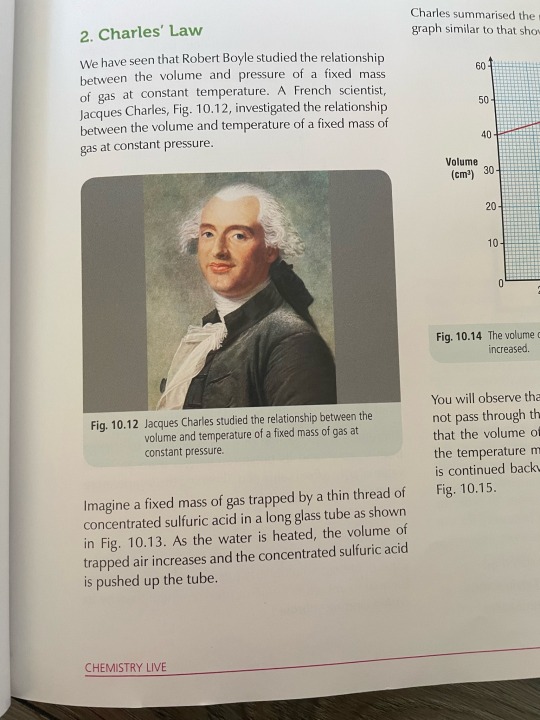
Charles Boyle and Gay-Lussac i hate you all and your stupid laws
3 notes
·
View notes
Note
I finally understood gay lussac's law thanks to you
glad to know that my silly comic was helpful! gl on your next chemistry assessment :)))
3 notes
·
View notes
